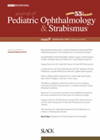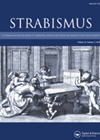
Journal Reviews
Improved suppression after surgery for intermittent exotropia
This study aimed to investigate the clinical factors associated with the recovery from suppression, with successful postoperative target motor alignment in 237 patients with intermittent exotropia. Mean age at surgery was 8.2 ±3.2 years and 48.5% were male. Preoperative angle...
Paralytic strabismus in Parry-Romberg syndrome
Parry-Romberg syndrome is a progressive hemifacial atrophy with idiopathic craniofacial disorder characterised by slowly progressive atrophy of soft tissues on one side of the face. A case is presented of acquired monocular elevation deficit in a child without restrictive component....
Sjogren’s syndrome in association with ophthalmoplegia
This is a case report of a 28-year-old female complaining of horizontal and vertical diplopia with inability to move her right eye and sudden onset right ptosis. She complained of retro-orbital pain with headache and a foreign body sensation in...
Amblyopia risk factors with nasolacrimal duct obstruction in newborns
This study compares amblyopia risk factors in 1) newborns with congenital nasolacrimal duct obstruction (CNLDO) and age-matched healthy controls, 2) newborns with unilateral and bilateral CNLDO and 3) affected eye and fellow eye of newborns with unilateral CNLDO. The authors...
Outcome of nasolacrimal probing in older children
The authors aimed to determine the success of nasolacrimal duct obstruction (NLD) probing in a cohort of patients older than four years with simple membranous obstruction. Eighteen patients were included in this retrospective study aged 5.6 years on average (4.1-10.6)....
OCT angiography findings in amblyopic eyes
In this study, optical coherence tomography angiography (OCTA) was used to detect the existence of any vascular dysfunction in superficial and deep retinal layers that accompany visual impairment in amblyopic eyes compared to fellow and control eyes. The study included...
Laser photocoagulation vs. intravitreal (IVT) aflibercept for ROP
The efficacy, recurrence rate and requirement for additional treatment were compared between laser photocoagulation and IVT of 1mg/0.025ml aflibercept in the treatment of retinopathy of prematurity (ROP). The study included 27 babies (51 eyes) who completed a follow-up period after...
Treatment efficacy of stage 4 ROP
This study aimed to determine the efficacy of combined vitrectomy and anti-VEGF injection for advanced stage 4 ROP with extensive neovascular proliferation (NF). The study included nine infants; six bilateral and three unilateral. Seven were female and the mean gestational...
Amblyopia prediction using Plusoptix
The aims of this study were to evaluate Plusoptix performance in amblyopia prediction, to examine the best readings for that prediction and to determine if it is sufficient to have one measure or more. Data were collected in a two-year...
CVI features in an Indian population
This study describes the predisposing factors and ophthalmic characteristics of children with cortical visual impairment (CVI) at a tertiary centre in India. This was a retrospective cross-section study of children <16-years-old over a four-year period. A review of 88 patients...
Orbital cellulitis outcomes for children
This paper discusses the clinical profile and multidisciplinary team (MDT) management outcomes in children treated for paediatric orbital cellulitis. This was a prospective study of 40 children with a mean age of 7.5 years (4-12). Unilateral orbital cellulitis cases had...
Infection prophylaxis and first visit timing for strabismus surgery
The authors undertook this study to characterise the practice patterns of paediatric ophthalmologists regarding their use of infection prophylaxis and timing of the first postoperative visit after strabismus surgery. A 10-question multi-choice questionnaire was circulated via American Association for Pediatric...






